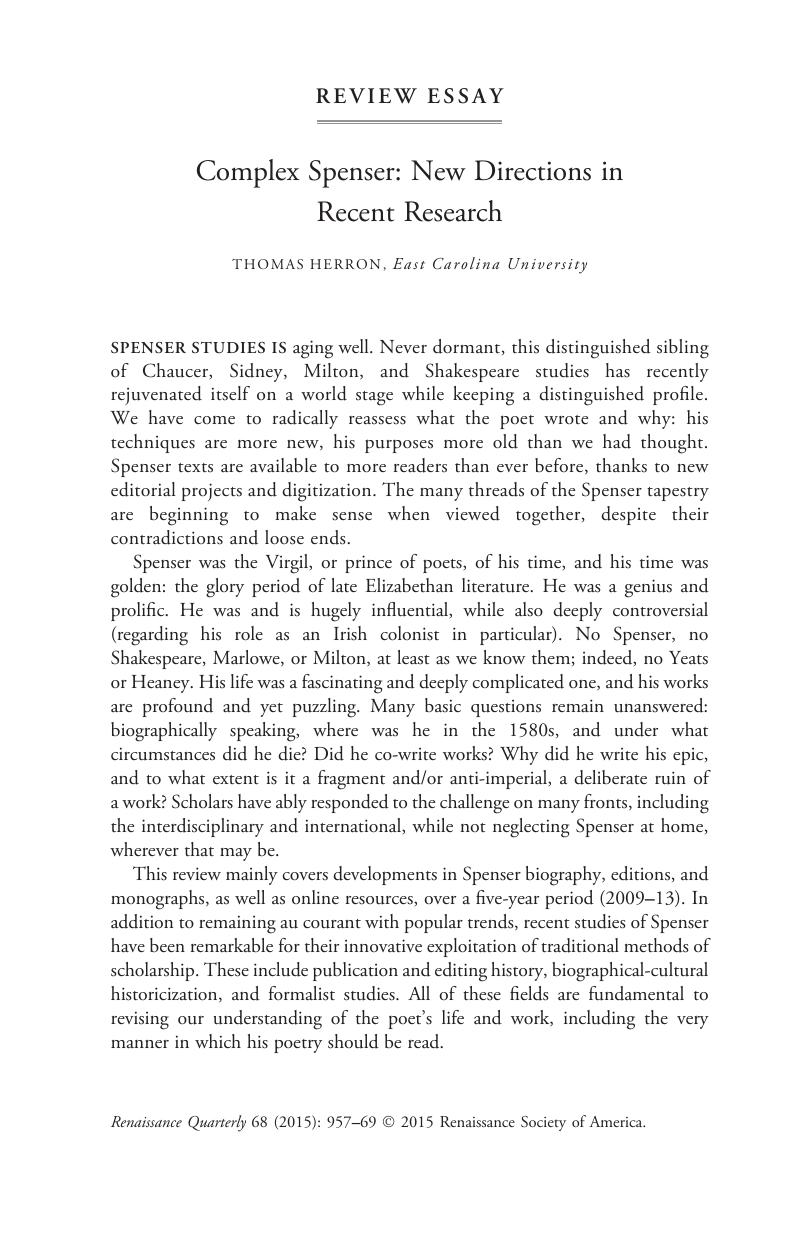No CrossRef data available.
Article contents
Complex Spenser: New Directions in Recent Research
Published online by Cambridge University Press: 20 November 2018
Abstract
An abstract is not available for this content so a preview has been provided. Please use the Get access link above for information on how to access this content.

- Type
- Review Essay
- Information
- Copyright
- Copyright © Renaissance Society of America 2015
References
Bibliography
Burlinson, Christopher, and Andrew Zurcher, eds. Edmund Spenser: Selected Letters and Other Papers. Oxford, 2009.Google Scholar
Campana, Joseph. The Pain of Reformation: Spenser, Vulnerability, and the Ethics of Masculinity. New York, 2012.10.5422/fordham/9780823239108.001.0001CrossRefGoogle Scholar
Danner, Bruce. Edmund Spenser’s War on Lord Burghley. New York, 2011.10.1057/9780230336674CrossRefGoogle Scholar
Grogan, Jane, ed. Exemplary Spenser: Visual and Poetic Pedagogy in The Faerie Queene. Aldershot, 2009.Google Scholar
Grogan, Jane. Celebrating Mutabilitie: Essays on Edmund Spenser’s Mutabilitie Cantos. Manchester, 2010.Google Scholar
Hecht, Paul. “Letters for the Dogs: Chasing Spenserian Alliteration.” Spenser Studies
25 (2010): 263–85.10.7756/spst.025.011.263-285CrossRefGoogle Scholar
Helfer, Rebecca. Spenser’s Ruins and the Art of Recollection. Toronto, 2012.10.3138/9781442660571CrossRefGoogle Scholar
Herron, Thomas. “Outfoxed? Mother Hubberds Tale, Adam Loftus, and Lord Burleigh in Irish Context.” Spenser Studies
28 (2013a): 221–32.10.7756/spst.028.009.221-232CrossRefGoogle Scholar
Herron, Thomas. Review of Edmund Spenser: A Life, by Andrew Hadfield. Renaissance Quarterly
66.2 (2013b): 740–42.Google Scholar
Klingelhofer, Eric. Castles and Colonists: An Archaeology of Elizabethan Ireland. Manchester, 2010.10.7228/manchester/9780719082467.001.0001CrossRefGoogle Scholar
Lethbridge, J. B., and Richard Danson Brown, eds. A Concordance to the Rhymes of The Faerie Queene: With Two Studies of Spenser’s Rhymes. Manchester, 2013.Google Scholar
McCabe, Richard, ed. The Oxford Handbook of Edmund Spenser. Oxford, 2010.10.1093/oxfordhb/9780199227365.001.0001CrossRefGoogle Scholar
Melehy, Hassan. The Poetics of Literary Transfer in Early Modern France and England. Aldershot, 2010.Google Scholar
Muir, Tom. “Specters of Spenser: Translating the Antiquitez.
” Spenser Studies
25 (2010): 327–61.Google Scholar
Prescott, Anne Lake, and Andrew Hadfield, eds. Edmund Spenser’s Poetry: A Norton Critical Edition. 4th ed. New York, 2014.Google Scholar
Walls, Kathryn. God’s Only Daughter: Spenser’s Una as the Invisible Church. Manchester, 2013.10.7228/manchester/9780719090370.001.0001CrossRefGoogle Scholar
Wilson-Okamura, David Scott. Virgil in the Renaissance. Cambridge, 2010.10.1017/CBO9780511762581CrossRefGoogle Scholar
Wilson-Okamura, David Scott. Spenser’s International Style.
Cambridge, 2013.10.1017/CBO9781139814652CrossRefGoogle Scholar
Digital Resources
Centering Spenser: A Digital Resource for Kilcolman Castle: http://core.ecu.edu/umc/Munster/.Google Scholar
Spenser Project Digital Archive: http://talus.artsci.wustl.edu/spenserArchivePrototype/.Google Scholar




